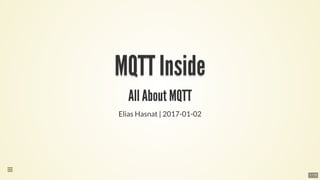Mqtt
- 3. MQTT - One to ManyMQTT - One to ManyMQTT - One to ManyMQTT - One to ManyMQTT - One to ManyMQTT - One to Many MQTT - One to Many MQTT - One to Many MQTT - One to Many MQTT - One to Many MQTT - One to Many MQTT - One to Many MQTT - One to Many MQTT - One to Many MQTT - One to ManyMQTT - One to Many > Publish-Subscribe A Publish Subscribe messaging protocol allowing a message to be published once and multiple consumers (applications/devices) to receive the message providing decoupling between the producer and consumer(s) > Publish A producer sends a message(publication) on a topic A consumer subscribes for messages on a topic > Subscribe A message server/broker matches publications to subscriptions If no matches the message is discarded If one or more matches the message is delivered to each matching subscriber/consumer 3 / 13
- 4. Anatomy of MQTTAnatomy of MQTTAnatomy of MQTTAnatomy of MQTTAnatomy of MQTTAnatomy of MQTT Anatomy of MQTT Anatomy of MQTT Anatomy of MQTT Anatomy of MQTT Anatomy of MQTT Anatomy of MQTT Anatomy of MQTT Anatomy of MQTT Anatomy of MQTTAnatomy of MQTT MessageMessageMessageMessageMessageMessage Message Message Message Message Message Message Message Message MessageMessage A topic forms the namespace Is hierarchical with each “sub topic” separated by a "/" An example topic space A house publishes information about itself on: <country>/<region>/<town>/<postcode>/<house>/energyConsumption <country>/<region>/<town>/<postcode>/<house>/solarEnergy <country>/<region>/<town>/<postcode>/<house>/alarmState <country>/<region>/<town>/<postcode>/<house>/alarmState And subscribes for control commands: <country>/<region>/<town>/<postcode>/<house>/thermostat/setTemp A subscriber can subscribe to an absolute topic or can use wildcards: Single-level wildcards “+” can appear anywhere in the topic string Multi-level wildcards “#” must appear at the end of the string Wildcards must be next to a separator Cannot be used wildcards when publishing 4 / 13
- 5. MQTT Pub SubMQTT Pub SubMQTT Pub SubMQTT Pub SubMQTT Pub SubMQTT Pub Sub MQTT Pub Sub MQTT Pub Sub MQTT Pub Sub MQTT Pub Sub MQTT Pub Sub MQTT Pub Sub MQTT Pub Sub MQTT Pub Sub MQTT Pub SubMQTT Pub Sub A subscription can be durable or non durable A publication may be retained >Durable * Once a subscription is in place a broker will forward matching messages to the subscriber immediately if the subscriber is connected * If the subscriber is not connected messages are stored on the server/broker until the next time the subscriber connects >Non-durable * The subscription lifetime is the same as the time the subscriber is connected to the server/broker * A publisher can mark a publication as retained The broker/server remembers the last known good message of a retained topic * The broker/server gives the last known good message to new subscribers 5 / 13
- 6. Constrained NetworkConstrained NetworkConstrained NetworkConstrained NetworkConstrained NetworkConstrained Network Constrained Network Constrained Network Constrained Network Constrained Network Constrained Network Constrained Network Constrained Network Constrained Network Constrained NetworkConstrained Network 1. Protocol compressed into bit-wise headers and variable length fields. 2. Smallest possible packet size is 2 bytes 3. Asynchronous bidirectional “push” delivery of messages to applications (no polling) 4. Client to server and server to client 5. Supports always-connected and sometimes-connected models 6. Provides Session awareness 7. Configurable keep alive providing granular session awareness 8. QoS level enable applications to know when a client goes offline abnormally 9. Typically utilises TCP based networks e.g. Webscokets 6 / 13
- 7. Constrained DevicesConstrained DevicesConstrained DevicesConstrained DevicesConstrained DevicesConstrained Devices Constrained Devices Constrained Devices Constrained Devices Constrained Devices Constrained Devices Constrained Devices Constrained Devices Constrained Devices Constrained DevicesConstrained Devices 1. Designed for constrained devices 2. Suited to applications / devices that may have limited resources available 3. 8 Bit controllers upwards 4. Low power Battery 7 / 13
- 9. Use cases for MQTTUse cases for MQTTUse cases for MQTTUse cases for MQTTUse cases for MQTTUse cases for MQTT Use cases for MQTT Use cases for MQTT Use cases for MQTT Use cases for MQTT Use cases for MQTT Use cases for MQTT Use cases for MQTT Use cases for MQTT Use cases for MQTTUse cases for MQTT 1. Push instead Pull 2. Reliable even when used with unreliable networks 3. Constrained Devices 4. Low bandwidth, high latency 5. Enterprise and Mobile 9 / 13
- 10. MQTT FeaturesMQTT FeaturesMQTT FeaturesMQTT FeaturesMQTT FeaturesMQTT Features MQTT Features MQTT Features MQTT Features MQTT Features MQTT Features MQTT Features MQTT Features MQTT Features MQTT FeaturesMQTT Features 1. 3 QoS Levels 2. Retained Messages 3. Topic Wildcards 4. Message Retainment 5. Persistent Sessions 6. Heartbeats QoS0 At most once delivery QoS1 At least once delivery QoS2 Exactly once delivery 10 / 13
- 11. Retained MessagesRetained MessagesRetained MessagesRetained MessagesRetained MessagesRetained Messages Retained Messages Retained Messages Retained Messages Retained Messages Retained Messages Retained Messages Retained Messages Retained Messages Retained MessagesRetained Messages 1. Last Known Good Value 2. Broker saves last message for a topic 3. Client decides if message is retained 4. Client receives retained message after subscribing 11 / 13
- 12. Message RetainmentMessage RetainmentMessage RetainmentMessage RetainmentMessage RetainmentMessage Retainment Message Retainment Message Retainment Message Retainment Message Retainment Message Retainment Message Retainment Message Retainment Message Retainment Message RetainmentMessage Retainment 1. Client defines how the message be retained 2. Broker sends the message on behalf of the client after the client stoped 3. Real Push 4. Useful for implementing on/off topic publishes 12 / 13

